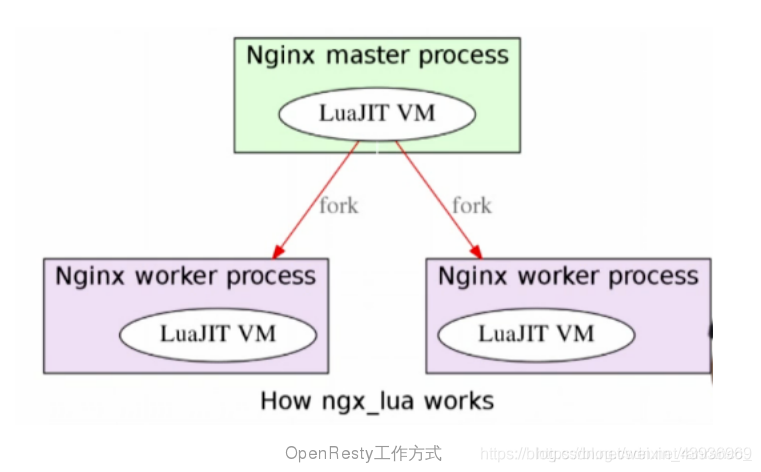一、什么是openresty?
OpenResty(又称: ngx_ openresty) 是一个基于NGINX的可伸缩的Web平台,由中国人章亦春发起,提供了很多高质歌的第三方模块。
OpenResty是一个基于 Nginx 与 Lua 的高性能 Web 平台,其内部集成了大量精良的 Lua 库、第三方模块以及大多数的依赖项。用于方便地搭建能够处理超高并发、扩展性极高的动态 Web 应用、Web 服务和动态网关。 通过汇聚各种设计精良的 Nginx 模块(主要由 OpenResty 团队自主开发),从而将 Nginx 有效地变成一个强大的通用 Web 应用平台。这样,Web 开发人员和系统工程师可以使用 Lua 脚本语言调动 Nginx 支持的各种 C 以及 Lua 模块,快速构造出足以胜任 10K 乃至 1000K 以上单机并发连接的高性能 Web 应用系统。
OpenResty的目标是让web服务直接运行在Nginx服务内部,利用Ngnix的非阻塞IO模型,对HTTP客户端请求和后端DB进行一致的高性能响应。
OpenResty访问Mysq|或Redis等,而不需要通过第三方语言( PHP、Python、Ruby )等来访问数据库再返回,这大大提高了应用的性能。
参考openresty中文官网http://openresty.org/cn
1、运行原理

Nginx 采用的是 master-worker 模型,一个 master 进程管理多个 worker 进程
- woker负责基本事件的处理
- master 负责一些全局初始化,以及对 worker 的管理
在OpenResty中,每个 woker 使用一个 LuaVM,当请求被分配到 woker 时,将在这个 LuaVM 里创建一个 coroutine(协程)协程之间数据隔离,每个协程具有独立的全局变量_G
二、利用OpenResty给nginx添加memcache(缓存前移的实现)
在上一篇博客lnmp架构(三)中,我们给php添加了memcache模块,现在我们利用OpenResty给nginx添加memcache模块,这样不用等待第三方返回,大大提高了应用的性能。
实验环境
| 主机(版本:ip) | 功用 |
|---|---|
| 虚拟机server1(rhel7.3:172.25.16.1) | lnmp环境主机 |
| 真机(rhel7.3:172.25.16.250) | 测试机 |
我们先关闭之前配置好的nginx,因为openresty是一个类似于nginx的服务,调用都是80端口。

step1 解压并源码编译openresty源码包:
tar zxf openresty-1.13.6.1.tar.gz
cd openresty-1.13.6.1
./configure --prefix=/usr/local/openresty
gmake && gmake install
step2 修改openresty的配置文件:
cd /usr/local/openresty/
cd nginx/
cd conf/
nginx -s stop #关闭之前的nginx服务
vim nginx.conf
1
2 user nginx nginx;
17 http {
18 include mime.types;
19 default_type application/octet-stream;
20 upstream memcache {
21 server localhost:11211;
22 keepalive 512;
23 }
69 location /memc {
70 internal; #只接收内部访问,不接受外部http访问。比较安全
71 memc_connect_timeout 100ms;
72 memc_send_timeout 100ms; #后端服务器数据回传时间
73 memc_read_timeout 100ms; #连接成功后,后端服务器响应时间
74 set $memc_key $query_string;
75 set $memc_exptime 300;
76 memc_pass memcache;
77 }
78
79 location ~ \.php$ {
#http的GET方法表示get、PUT方法表示set
80 set $key $uri$args;
81 srcache_fetch GET /memc $key; #请求php页面时,会先去memcache中找。如果没有,正常访问;
82 srcache_store PUT /memc $key; #访问结束后将结果存到memcache中,下次访问时直接从缓存中取
83 root html;
84 fastcgi_pass 127.0.0.1:9000;
85 fastcgi_index index.php;
86 # fastcgi_param SCRIPT_FILENAME /scripts$fastcgi_script_name;
87 include fastcgi.conf;
88 }



step3 检查没有语法错误之后开启服务,查看端口号
[root@server1 html] /usr/local/openresty/nginx/sbin/nginx -t
[root@server1 html] /usr/local/openresty/nginx/sbin/nginx
[root@server1 html] netstat -tlnp

step4 将测试文件复制到openresty的默认发布目录下:
cp /usr/local/lnmp/nginx/html/index.php /usr/local/openresty/nginx/html/
cp /usr/local/lnmp/nginx/html/example.php /usr/local/openresty/nginx/html/
step5 启动openstry:
/usr/local/openresty/nginx/sbin/nginx

step6 测试:
ab -c 10 -n 5000 http://172.25.254.1/index.php
ab -c 10 -n 5000 http://172.25.254.1/example.php


通过测试可以发现:相比上一篇博文中的一层缓存,再加一层缓存后,速度大大提高,且出错率为0
现在的web服务器是 nginx+memcache等于openresty
openResty是nginx的plus版,很多nginx做不到的事情,可以用openResty来做
curl -I 172.25.16.1

此时服务软件是openresty
